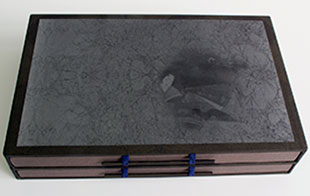 The Japan Project By Brad Freeman Chicago: Brad Freeman, 2013/2014. Edition of 10. 21 x 12.25 x 3" box with two drawers. Top drawer houses Sumo Geisha Sashimi and Colophon & Instructions for Viewing. Bottom drawer houses Floating Bridge of Dreams. Box paper-covered with digital pattern images from Floating Bridge of Dreams. Each drawer has a wood and cloth pull for opening. Colophon & Instructions of Viewing: 9.9 x 8.25”; 4 pages including front and back boards. Paper-covered boards with cloth spine. Signed and numbered by the artist. Sumo Geisha Sashimi: 8.25 x 7.25" closed, 8.25 x 13" open; 86 pages. Cover offset printed in black, cyan, yellow, and silver/magenta. Interior pages inkjet printed on Asuka kozo papers. Bound using traditional Japanese stab binding. Floating Bridge of Dreams: 19 x 11.5”; 36 pages. Cover offset printed in black + pattern YK and metallic ink on Mohawk Superfine. Bound using Japanese stab binding. Paper-covered boards and cloth spine. Interior pages a combination of inkjet and offset print on Asuka and Mohawk Superfine papers. Ideas / Index / Colophon: "All the photographs (except two images downloaded from the Library of Congress Website, digital collages, design, prepress, printing, and binding are by me, Brad Freeman. The printing of the two books is either offset on the Heidelberg GTO with Mohawk Superfine and Astrobrite black or inkjet on the Epson 9800 with Asuka kozo paper. All printing was done at the Center for Book and Paper, Columbia College Chicago, in 2012 and 2013. The binding and box-drawer construction were completed in 2014 at my studio in Chicago. "Most of the photographs for this project were taken while on a trip to Japan in 2011 with my wife Yukie Kobayashi. A few photographs from Chicago, Portugal, and Newfoundland are included. "SUMMO GEISHA SASHIMI consists of two sequences – on each verso page a single photograph of a sumo mater is repeated over and over through all the pages while zooming in on a solitary detail – one moment of time is displayed as the view comes closer and closer to a particular detail of the larger photograph on each subsequent page. In a complementary manner, a sequence of photographs taken during a period of about twenty minutes is presented on all the recto pages. The intention was to take advantage of the book's verso-recto form and create a correspondence among the images across the gutter and through the pages that would not have been possible if each sequence was presented alone. " A visual poem, FLOATING BRIDGE OF DREAMS is a presentation of images arranged in such a way as to provide associations and enhance their meaning as the pages are turned with an ineluctable drive toward the end. The title comes from a phrase used in The Tale of Genji by Shikibu Murasaki. Three kinds of paper – Mohawk Superfine, Asuka kozo, and Astrobrite black – were used as a way to explore the possibilities of various offset and inkjet printing techniques. Also, the different weight, drape, and texture of the papers enhance the haptic quality of the viewing experience. "Playing with and making visual patterns – some created from by photographs – was given a fresh impetus in Japan and Portugal by, for instance , kimonos, decorative paper, ceramic tiles, and architectural details….The patterns in FLOTATING BRIDGE were created from my photographs – highly manipulated in Photoshop – of the garden my wife Yukie cultivates fat our home in Chicago…. "The photographs in the books here were developed into sequentially arranged associative collages – the trace of origin remains." JAB draft on sumo geisha sashimi: "The photographs that comprise the book sumo geisha sashimi were taken by me during a trip to Japan in 2011. The photograph of a televised sumo wrestling match with the audience in the background repeats on each verso page through the entire book. The image enlarges slightly with each turn of the page — we are zooming in toward a geisha in the audience. “The images on the recto are a sequence of photographs taken during a period of about thirty minutes of a man butchering (sabuku — cutting with a sharp blade) a tuna at the Tokyo fish market. This is an early step in the process of making sashimi. "The book consists of two temporal systems appearing at the same time, with one time system on the verso and one on the recto. Both temporal systems exist simultaneously on the plane of the page spread with the gutter separating the two systems. On each verso page one moment is captured in a photograph and gradually enlarges with each turn to reveal the geisha. On the recto a sequence of moments captured photographically displays the butchering of a tuna. "The codex form provides the perfect container for linking these two time systems to create an associative viewing experience. "A couple of the issues on my mind during the making of this book included a feminist critique on the position of the geisha and the ecological implications of over-fishing. I was also considering the idea of performance – the wrestling match and the butchering of the tuna are performances with an audience. The geisha in this case is in the audience — a role reversal for her since she is usually the performer — geisha means artist in Japanese and her performances include dancing, singing, and playing a musical instrument."
|